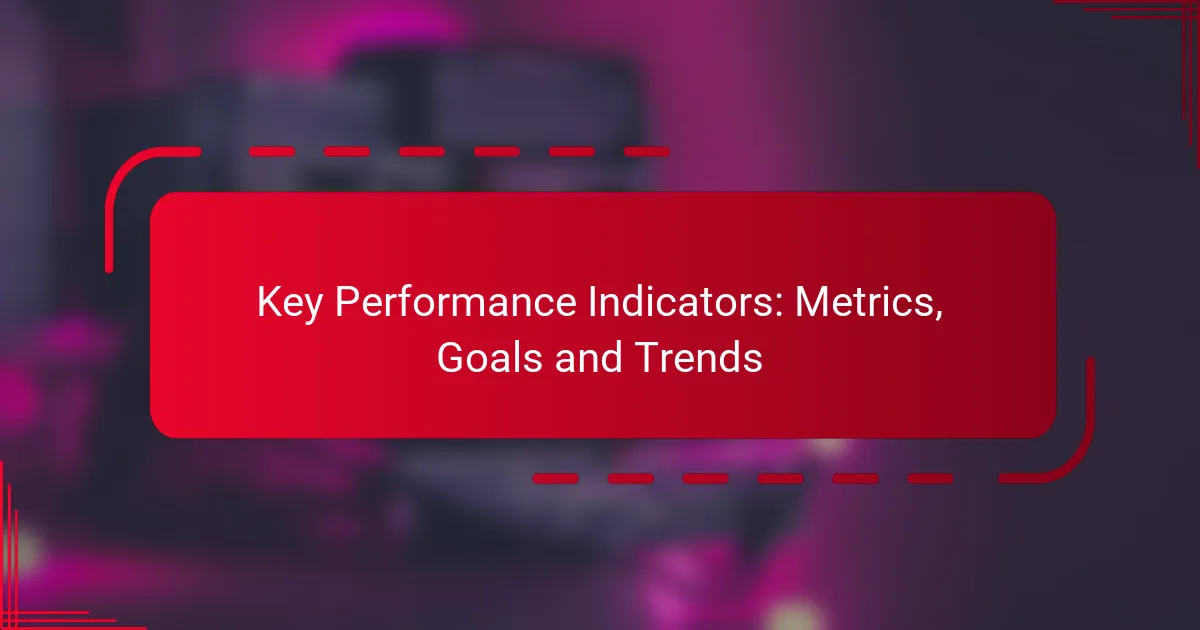Key performance indicators (KPIs) are vital metrics that assess the success of advertising campaigns by providing insights into user engagement and return on investment. In 2023, the focus on customer-centric metrics and technological advancements is reshaping how businesses set and measure their goals, emphasizing the need for specific, measurable, and actionable objectives. By leveraging data analysis and comprehensive attribution models, organizations can optimize their strategies and enhance long-term customer relationships.

What are the key performance indicators for display advertising?
Key performance indicators (KPIs) for display advertising are essential metrics that help evaluate the effectiveness of ad campaigns. These indicators provide insights into user engagement, cost efficiency, and overall return on investment, guiding marketers in optimizing their strategies.
Click-through rate (CTR)
Click-through rate (CTR) measures the percentage of users who click on an ad after seeing it. A higher CTR indicates that the ad is relevant and engaging to the audience. Typically, a good CTR for display ads ranges from 0.5% to 2% depending on the industry.
To improve CTR, focus on creating compelling ad copy and visuals that resonate with your target audience. Avoid generic messaging and instead tailor your ads to specific demographics or interests.
Cost per acquisition (CPA)
Cost per acquisition (CPA) calculates the total cost of acquiring a customer through advertising. This metric is crucial for understanding the financial efficiency of your campaigns. A lower CPA indicates a more cost-effective strategy, with benchmarks varying widely by industry, often between $10 to $100.
To manage CPA effectively, analyze which channels and ads yield the best conversion rates. Adjust your budget allocation to prioritize high-performing ads while minimizing spend on underperformers.
Return on ad spend (ROAS)
Return on ad spend (ROAS) measures the revenue generated for every dollar spent on advertising. A ROAS of 4:1 is often considered a good target, meaning for every $1 spent, $4 in revenue is generated. This metric helps assess the profitability of your campaigns.
To enhance ROAS, continually test different ad creatives and targeting strategies. Use A/B testing to identify which ads perform best and allocate resources accordingly.
Impressions and reach
Impressions refer to the total number of times an ad is displayed, while reach indicates the number of unique users who see the ad. Both metrics are vital for understanding the visibility of your campaigns. High impressions with low reach may suggest ad fatigue among users.
To optimize impressions and reach, consider frequency capping to avoid overexposing the same audience to your ads. Diversifying ad placements across various platforms can also broaden your reach.
Conversion rate
Conversion rate measures the percentage of users who complete a desired action after interacting with an ad, such as making a purchase or signing up for a newsletter. A typical conversion rate for display advertising ranges from 1% to 5% depending on the industry and campaign goals.
To boost conversion rates, ensure that your landing pages are optimized for user experience and aligned with the ad content. Clear calls to action and streamlined navigation can significantly enhance the likelihood of conversions.

How to set effective goals for KPIs?
Effective goals for Key Performance Indicators (KPIs) should be specific, measurable, achievable, relevant, and time-bound. This approach ensures that the goals are clear and actionable, allowing organizations to track their performance accurately.
SMART goal framework
The SMART framework is a widely used method for setting effective goals. Each goal should be Specific, Measurable, Achievable, Relevant, and Time-bound. For example, instead of saying “increase sales,” a SMART goal would be “increase sales by 15% in the next quarter.”
When applying the SMART criteria, ensure that each component is addressed. Specificity helps clarify what is to be achieved, measurability allows for tracking progress, achievability ensures the goal is realistic, relevance aligns with broader business objectives, and time-bound sets a clear deadline.
Benchmarking against industry standards
Benchmarking involves comparing your KPIs against industry standards to gauge performance. This practice helps identify areas for improvement and sets realistic targets based on what similar organizations achieve. For instance, if the average customer satisfaction score in your industry is 80%, setting a goal of 75% may be a reasonable starting point.
To effectively benchmark, gather data from reliable sources such as industry reports or trade associations. Regularly review these benchmarks to adjust your goals as industry standards evolve.
Aligning goals with business objectives
Aligning KPI goals with broader business objectives ensures that every effort contributes to the organization’s overall strategy. For example, if a company’s objective is to enhance customer loyalty, a relevant KPI goal might be to improve the customer retention rate by a specific percentage within a defined timeframe.
To maintain alignment, regularly communicate the importance of each KPI goal to your team. This fosters a shared understanding of how individual contributions impact the company’s success, motivating employees to work towards common objectives.

What trends are shaping KPIs in 2023?
In 2023, key performance indicators (KPIs) are increasingly influenced by customer-centric metrics, technological advancements, and comprehensive attribution models. Businesses are focusing on long-term customer relationships, leveraging artificial intelligence for data analysis, and recognizing the importance of tracking performance across multiple channels.
Increased focus on customer lifetime value (CLV)
Customer lifetime value (CLV) has become a critical KPI as companies aim to understand the long-term profitability of their customer relationships. By analyzing CLV, businesses can allocate resources more effectively, ensuring marketing efforts are directed towards retaining high-value customers.
To calculate CLV, consider factors such as average purchase value, purchase frequency, and customer lifespan. For example, if a customer spends an average of $100 per purchase, buys four times a year, and remains a customer for five years, their CLV would be $2,000. This insight can guide strategic decisions on customer acquisition and retention.
Integration of AI in performance measurement
The integration of artificial intelligence (AI) in performance measurement is transforming how organizations track and analyze KPIs. AI tools can process vast amounts of data quickly, uncovering patterns and trends that may not be visible through traditional analysis methods.
For instance, AI can automate the monitoring of KPIs in real-time, allowing businesses to make data-driven decisions promptly. Companies should invest in AI solutions that align with their specific needs, ensuring they can harness the full potential of their performance data.
Shift towards multi-channel attribution
Multi-channel attribution is gaining traction as businesses recognize that customer journeys often span various platforms and touchpoints. This approach allows organizations to assign credit to different channels based on their contribution to conversions, providing a more accurate picture of marketing effectiveness.
Implementing multi-channel attribution requires robust tracking mechanisms and analytics tools. Companies should consider using models such as linear attribution, which distributes credit evenly across all channels, or time decay attribution, which gives more weight to channels closer to the conversion. This shift helps optimize marketing budgets and improve overall campaign performance.

How to analyze KPI performance?
To analyze KPI performance effectively, start by collecting relevant data and comparing it against established benchmarks or goals. This process helps identify trends, strengths, and areas needing improvement.
Utilizing analytics platforms like Google Analytics
Google Analytics is a powerful tool for tracking and analyzing website performance metrics. By setting up goals and events, you can monitor user interactions and conversions, which are critical KPIs for online businesses.
Consider integrating Google Analytics with other tools like Google Data Studio for enhanced reporting capabilities. This combination allows for real-time data analysis and a comprehensive view of user behavior.
Regular reporting and dashboard creation
Creating regular reports and dashboards is essential for monitoring KPI performance over time. These reports should highlight key metrics, trends, and insights, enabling stakeholders to make informed decisions.
Use tools like Tableau or Power BI to create interactive dashboards that visualize data effectively. Aim for weekly or monthly reports to keep your team updated and aligned with performance goals.
Data visualization techniques
Data visualization techniques, such as charts and graphs, can help convey complex KPI data in an easily digestible format. Utilizing bar graphs, line charts, and pie charts can illustrate performance trends and comparisons clearly.
When visualizing data, focus on clarity and simplicity. Avoid cluttered visuals; instead, highlight the most important KPIs to ensure your audience quickly grasps the insights.
![]()
What are the prerequisites for effective KPI tracking?
Effective KPI tracking requires a solid foundation of clear objectives, reliable data sources, and a well-defined strategy. These prerequisites ensure that the metrics you monitor provide meaningful insights into performance and guide decision-making.
Establishing clear tracking mechanisms
To track KPIs effectively, you need to establish clear mechanisms that define how data will be collected and analyzed. This could involve using software tools that automate data gathering and reporting, ensuring accuracy and timeliness.
Consider setting up dashboards that visualize key metrics in real-time. This allows stakeholders to quickly assess performance and make informed decisions. Regularly reviewing these mechanisms helps identify any gaps or inaccuracies in data collection.
Defining target audience segments
Identifying and defining target audience segments is crucial for effective KPI tracking. By understanding who your audience is, you can tailor your metrics to reflect their behaviors and preferences, leading to more relevant insights.
Utilize demographic data, purchase history, and engagement patterns to create distinct segments. This approach enables you to set specific KPIs for each group, allowing for more targeted marketing strategies and improved performance measurement.
Integrating marketing tools and platforms
Integrating various marketing tools and platforms is essential for comprehensive KPI tracking. This integration allows for seamless data flow between systems, providing a holistic view of performance across channels.
For example, connecting your CRM with email marketing and social media platforms can help track customer interactions and conversions more effectively. Ensure that all tools used are compatible and that data is synchronized regularly to maintain accuracy in your KPI assessments.

How do KPIs differ across industries?
Key Performance Indicators (KPIs) vary significantly across industries due to differing goals, operational processes, and customer interactions. Each sector tailors its KPIs to reflect its unique challenges and objectives, impacting how success is measured.
Comparison of KPIs in retail vs. B2B
In retail, KPIs often focus on metrics like sales per square foot, inventory turnover, and customer foot traffic. These indicators help retailers assess their operational efficiency and customer engagement in a fast-paced environment where consumer preferences can shift rapidly.
Conversely, B2B companies prioritize KPIs such as customer acquisition cost, customer lifetime value, and lead conversion rates. These metrics are essential for understanding long-term profitability and optimizing sales strategies, as B2B transactions typically involve longer sales cycles and more complex relationships.
While both sectors aim for profitability, the retail industry leans towards immediate sales metrics, whereas B2B focuses on relationship-building and long-term value. Businesses should choose KPIs that align with their specific operational models and customer interactions to ensure effective performance measurement.
